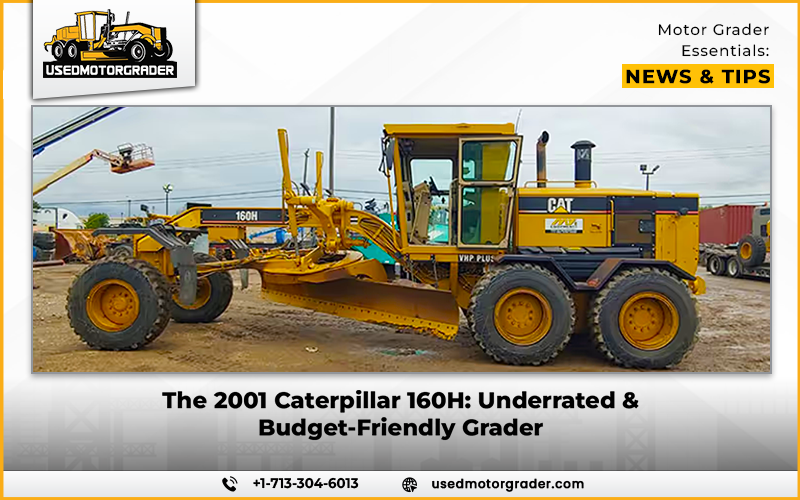The Quiet Workhorse in the Grader World
In terms of dependable road work, the 2001 Caterpillar 160H has had a silent reputation as being one of the most reputable motor graders of all time. One of its model years, the 2001 model, stands out, not because of fancy features and high-tech gadgets, but because it was a simple, no-nonsense, reliable car. With the market becoming saturated with complicated electronics and expensive price tags, this machine has turned out to be a sort of secret gem to those customers who are not interested in the looks and are more focused on the functionality. The 2001 Cat 160H still makes a lot of sense, whether you are a small contractor, a municipal road department, or just someone who is trying to stretch their fleet budget.
Specs and Performance That Still Hold Up
The 2001 Caterpillar 160H is not only a relic, but a fully functional machine that still satisfies the needs of numerous job sites. It was fitted with a Cat 3176C engine, which made approximately 185 to 200 net horsepower, depending on the configuration. The 160H has an operating weight of about 31,000 lbs and a 14-foot moldboard and is capable of road maintenance, ditch cutting, snow clearing, and fine grading. It also has the direct drive power shift transmission of Caterpillar, which provides smooth gear shifts and good torque in all 8 forward and 6 reverse gears. It may not be as modernly automated, but it definitely compensates in pure, physical performance.
Known for Durability and Simplicity
The mechanical simplicity of the 160H, particularly the models of the early 2000s, is one of its greatest attractions. It is beautiful in the simplicity of this machine. It was constructed when graders were rugged, easy to maintain, and less dependent on complicated electronics. This translates to reduced diagnostic headaches and reduced repair expenses in the long term. Most experienced operators will tell you that the 160H was a long-haul machine, and it is not uncommon to find machines with 10,000+ hours still grading like they were new. These machines were over-engineered in comparison to the current standards, and that is precisely the reason why they are still at work 20 years later.
Cost-Effective for Smaller Contractors and Municipal Use
The price of the 2001 Caterpillar 160H is what makes it so appealing in the current market of used equipment. Whereas new graders may cost as much as 300,000 dollars. A well-kept 160H may sell for a small fraction of that, as little as 100,000 dollars, depending on hours and condition. It provides a high ROI to those who do not require all the technology of new models. Municipalities especially appreciate the model for common road maintenance, snow plowing, and gravel road maintenance. It performs well without straining the budget of contractors working on a smaller budget. In addition, insurance and registration fees tend to be cheaper on older units, which further lowers operating expenses.
Operator Comfort and Control for Its Time
While the 160H may not match the luxurious operator cabs of today’s graders, it holds its own in terms of comfort and ease of use. The 2001 model came with an enclosed ROPS cab, good visibility, and intuitive control levers that offered precise blade movement. The seat is fully adjustable, and while the suspension isn’t as advanced as newer models. It still provides a stable ride across rough terrain. Veteran operators often appreciate the tactile feedback and full mechanical control. This model offers no touchscreens, no menus, just straightforward blade control and machine response.
Common Wear Areas and What to Check Before Buying
As with any used machine, especially one over 20 years old, potential buyers need to be aware of common wear points. Inspect the blade circle and articulation joints for play or excessive wear. These are areas that take on a lot of stress during grading. Check the hydraulics for leaks or sluggish response, and ensure the transmission shifts smoothly through all gears. Also, look for cracks in the frame, signs of overheating in the engine, and unusual noises under load. A well-kept 160H with solid maintenance records and a clean history can easily give you several more years of productive work.
Why the 160H Still Has a Place in Modern Fleets
Even in an industry where newer is often considered better. The 160H has earned a lasting spot in fleets across the country. Its rugged build, manageable size, and familiar controls make it ideal as a backup grader or a primary machine for smaller-scale jobs. And thanks to the widespread use of this model over the years, parts are still readily available, both OEM and aftermarket. For operations that don’t rely on high-tech grade control or telematics, the 160H remains a solid, trustworthy option. It’s a machine that still performs the job without needing a software update to do it.
A Smart Buy for the Right Operator
The 2001 Caterpillar 160H may not win awards for innovation or modern design. But that’s exactly why it continues to shine for value-focused buyers. It’s tough, affordable, easy to work on, and more than capable of tackling real-world jobs for contractors who know what they’re doing and don’t mind working with classic equipment. This model offers a great balance of reliability and performance. As long as someone has cared for it well, the 160H is more than just a “used grader.” It’s a dependable workhorse that still earns its keep, one pass at a time.


